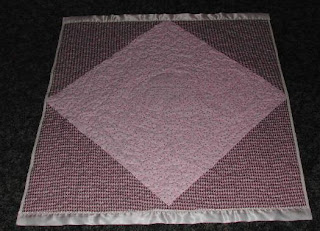Where should I start? New work... old work? I've decided to start with one of my earliest quilts because of the history and story that goes along with it. (And because it is still in my possession.)
I began this quilt back in the 1970's. I was in my 20's, already married. It was a very busy stage of my life; I had a pre-schooler and a baby, a farmer husband, and I was still finishing up my college degree. I wanted to make a quilt for my older brother and his soon-to-be-wife as a wedding present.
The basic design, or at least the flower blocks, came from a magazine - now long lost. The flower blocks are hand-appliqued and then details were hand-embroidered with floss. I figured I could work on it late at night in front of the TV. (That much has not changed in all these years. I still like to do hand work while watching TV. It fools me into thinking I'm not as much a 'couch-potato' as I really am.)
Anyway, I set to work, but did not even have the blocks finished before the wedding. I can't remember now what I ended up giving as a wedding gift, but it wasn't the unfinished quilt. A few years later, my younger brother was about to marry, so I thought, "I'll finish the flower quilt for him." More blocks were worked on until I finally had enough for the quilt, but again I ran out of time. I just couldn't get it put together and quilted by the wedding day.
And so the flower blocks sat in a box for maybe 5 or 6 years, waiting for me to have the time to finish the quilt. Meanwhile, I'd had my third child, and a full-time teaching job at the neighboring public school. Most of my sewing efforts now centered on practical things like pj's and kid clothes.
Every so often I'd glance at the box with my flower squares and dream about finishing it. Finally, I decided that my older brother's wife should at least have the appliqued squares that were originally meant for them. After all she is a professional seamstress; she could finish the quilt. I wrapped the box of squares and gifted them to her. At least I didn't have to feel that guilty tug everytime I thought of them. My intentions were good, and so were hers, but 10 or so years later (!) she gifted those very squares back to me saying sheepishly that she just didn't have the time to work on it.
Well, by this time, my oldest was getting ready to fly the nest. I had a teenager and a 10 year old, and still my full time teaching career. But times were changing and my 24 year marriage to that farmer was ending. It was a time of great emotional upheaval, and there were really two activities that helped me keep my sanity. One was walking (I'd walk 5-10 miles up and down hills each time I went out. -Provided lots of meditation time ... or just a chance to scream into the wind.); the other was sewing. Sewing seems to soothe some need I have to create. It just makes me feel good. I began sewing again with a vengence. And the first project I did was to finish this quilt!

I chose a flower garden cotton print to frame the squares. It has faded some over the last 15 years. Dark green leading sets the squares off, and the borders make it large enough for a queen size bed. My mom is an accomplished quilter herself. (I learned my sewing skills from her.) Mom hand-quilted this quilt for me, and the neat small stiches look like love to me. Finally, after 20+ years, the Sister-In-Law Flower Garden quilt was completed. Now I just can't give it away. There's too much of my own personal history tied up in this quilt. I remember so many things everytime I see it. It's place of honor is on our guest bed to minimize wear and tear, while still having it out and being used.

 I've made many quilts since this first one, but none that I've loved more. Part of the creation process is putting a piece of yourself into what's created. This quilt has some major chunks of me in it.
I've made many quilts since this first one, but none that I've loved more. Part of the creation process is putting a piece of yourself into what's created. This quilt has some major chunks of me in it.













































